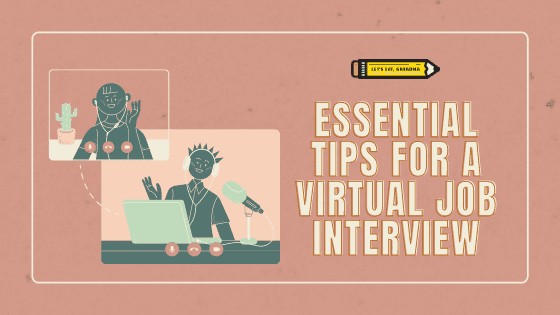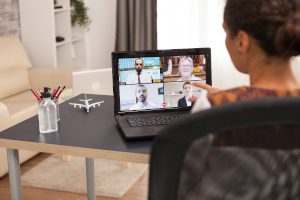5 Tips to Help You Ace Virtual Interviews

Your next job interview will likely be virtual. Video interviews have some important differences that you should be prepared for. Here are 5 tips for virtual interviews that will help you land the job!
By: Katelyn Skye Bennett | Contributor for Let’s Eat, Grandma
Virtual interviews have become the norm since the United States shut down back in March, but many of us are still getting the hang of etiquette and presentation on screen!
What are the new social rules, and do you really have to wear pants if only your face is visible? Grandma has broken down the vital facts on video interviews into five key parcels of wisdom, so grab a pen and take some notes.
5 Essential Video Interview Tips
Want more job search tips? Sign up for our newsletter!
1) “What should I wear?”
When you’re in person, blues and greyscale neutrals tend to be positive colors to wear, whereas red and orange can have a jarring effect on the employer. This holds true on virtual platforms as well, as vibrant colors are only intensified on camera. Additionally, patterns don’t work well virtually. They can be distracting or distorted due to the effect of the screen.
 As for the pants question, let’s address it upfront: Yes, Grandma does advise that you hide your underwear with real clothes. Even though you’re in home, you should still wear clothes that would be suitable for an interview.
As for the pants question, let’s address it upfront: Yes, Grandma does advise that you hide your underwear with real clothes. Even though you’re in home, you should still wear clothes that would be suitable for an interview.
There are two reasons for this: One is the subconscious effect that dressing up plays, helping you feel more professional and prepared for the interview.
The second is a precaution, on the off chance that you have to stand up for some unforeseen reason or your camera tips. If you need an example, here’s one viral video of a Zoom mishap…
2) “How do I set up my shot?”
Good question, because you absolutely need your camera on. Having that visual changes employers’ perceptions of you because they can get a better read on your professionalism and personality.
There are several things to note about setting up your camera, but it all boils down to simplicity. You’ll want to find an uncluttered room — free of mess and background noise. You’ll also want a solid background, one that you and your chosen outfit will stand out against.
Some platforms offer the ability to blur out your background or make it look like you’re in an empty office room if you really can’t find a clutter-free location, but keep it minimal. Make sure there are no photos of your own head floating in the background, because yes, I’ve seen that happen, and it’s highly distracting.
Lighting is a huge factor as well. If you’re lit up from behind, the employer won’t be able to see your face. If you’re in too dim of a room, the setting will be too shadowy. Since most of communication is nonverbal, you’ll really want the hiring manager to be able to see you clearly in order to make the best impression.

Be sure to set up your camera angle beforehand and make sure you have enough non-intrusive lighting.
So what do you do? Try natural light when possible, criss-cross a couple lights in front of you, and make sure to practice on camera before the interview to get the lighting and angles right.
Finally, set up your camera so that your face and shoulders are front and center. You don’t want to cut off your face by angling the camera too far up or to display awkward top space by slanting it too far down. Again, practicing on the platform beforehand will help you get this just right. If Grandma can do it, so can you.
3) “How do I use this technology?”
If you’re not familiar with the interview platform, explore it the day before your interview. Zoom, Microsoft Teams, Cisco Webex, Google Meet, and Skype are common ones. Familiarize yourself with the settings and options available to you, including chat boxes and background images.
Test your tech. It deserves its own point so we say once again: practice on the platform! Get comfortable with the video platform’s functions and test them with a friend, housemate, family member, or another device of your own to make your image as clear and centered as possible. Once you figure that out, it won’t change much.
Test the audio too. If it’s not working, make sure the platform is connecting to the same mic you’re using. Are you familiar with navigating those audio settings? Could the issue be your headphones themselves?
To avoid awkward or unprofessional silences when you’re first introduced, test your audio beforehand and again when you log in to the interview. Some platforms give you the option to make sure your video and audio are working before you enter the room. Take advantage of that, and you’ll be ready to go once you join the meeting.

Just like in a regular interview, keep an eye on your posture and body language. (Especially since you can see yourself!)
4) “When should I arrive at a virtual interview?”
In-person, you might be arriving up to 15 minutes before the scheduled time. Virtually, this is too soon as video interview “rooms” have stricter boundaries, but you do want to be exactly on time.
One or two minutes before the scheduled time is wise in case your clocks are different. Exactly on the dot is perfect. Any later, and the interviewer may start counting. Interviewers still have this time blocked out for you, as with in-person interviews, but may be more attentive to delays when sitting in an empty Zoom room than when they are in a physical office with a bit more to occupy them.
5) “What else do I need to know?”
Watch your body language, as in a regular interview. Is your hand on your face? Are you picking at yourself? Are you unintentionally making strange faces when they ask questions you have to think harder about? In video interviews, you can see yourself on screen, so there’s no excuse to continue these bad habits anymore. If you catch yourself doing something distracting with your facial expressions or body language, adjust it for the rest of your interview. Sit up straight and be confident, keeping eye contact with the camera. You’ve got this.
What’s more, you still ought to practice verbalizing your responses beforehand. While there are some differences in video interviews, like the arrival time, backgrounds, and new technology, the basics are the same.
Know the company and know yourself. Come prepared with responses as well as questions, and don’t forget to follow up with a thank you email after the fact!
